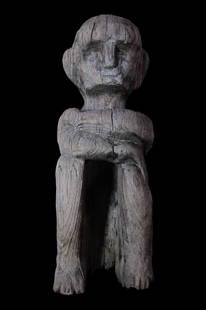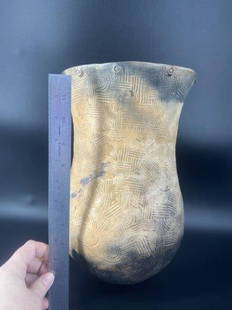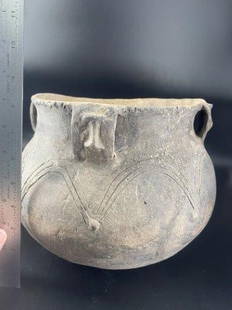
20th C. Easter Island Carved Wood Moai Kavakava
Similar Sale History
View More Items in Tribal & Native American ArtifactsRelated Tribal & Native American Artifacts
More Items in Tribal & Native American Artifacts
View MoreRecommended Art
View More






Item Details
Description
South America, Chile, Easter Island, ca. mid 20th century CE. Finely carved from a single piece of wood, an ancestor figure (Moai Kavakava) from the Rapa Nui culture of Easter Island, characteristically depicted as an emaciated, slightly hunched male with projecting ribs, a notched spine, and spindly arms at his sides. His oversized head presents an expressive countenance beneath a domed cranium, with thick ridged brows framing hollowed eye orbitals, a large, curved projecting nose with flared nostrils, an open mouth presenting a toothy grimace, and a jutting, goateed chin. His elongated ears appear to be adorned by round ornaments. Size: 16.25" H (41.3 cm); 17.25" H (43.8 cm) on included custom stand.
The term mo'ai kavakava stems from the word mo'ai referencing the monumental monolithic anthropomorphic figures found on Easter Island, and the work kavakava literally means ribs. Scholars know very little about these figures; however, it is generally believed that they are intended to represent starving ancestors or possibly demons. Some have suggested that such figures were traditionally worn around the necks of men engaged in ceremonial dances. These figures inspired the works of the famous German Expressionist artist Max Ernst, and Maoi Kavakava figures have been found in the French surrealist artist Andre Breton's collection.
Easter Island (Rapa Nui or Isla de Pascua) is a Chilean island located in the southeastern Pacific Ocean - at the point most southeast of the Polynesian Triangle of Oceania. Famous for its moai - colossal statues created by the Rapa Nui peoples, Easter Island became a UNESCO World Heritage Site in 1995. Scholars believe that Polynesian people settled on Easter Island between 700 and 1100 CE. They built a robust culture as the island's impressive stone moai and other artifacts suggest.
See a similar example if the Los Angeles County Museum of Art (M.2008.66.6) and the Metropolitan Museum of Art, New York (1979.206.1491).
For additional information, see: Wardwell, Allen. Island Ancestors: Oceanic Art from the Masco Collection. [Seattle]: University of Washington Press, 1994. Harding, Julian. "Pacific Treasures: the Masco Collection Goes to Los Angeles." Tribal Art no.50 (2008): 68-73.
Provenance: private New York, New York, USA collection; ex-private Vermont, USA collection, acquired 1970s
All items legal to buy/sell under U.S. Statute covering cultural patrimony Code 2600, CHAPTER 14, and are guaranteed to be as described or your money back.
A Certificate of Authenticity will accompany all winning bids.
We ship worldwide to most countries and handle all shipping in-house for your convenience.
#129676
The term mo'ai kavakava stems from the word mo'ai referencing the monumental monolithic anthropomorphic figures found on Easter Island, and the work kavakava literally means ribs. Scholars know very little about these figures; however, it is generally believed that they are intended to represent starving ancestors or possibly demons. Some have suggested that such figures were traditionally worn around the necks of men engaged in ceremonial dances. These figures inspired the works of the famous German Expressionist artist Max Ernst, and Maoi Kavakava figures have been found in the French surrealist artist Andre Breton's collection.
Easter Island (Rapa Nui or Isla de Pascua) is a Chilean island located in the southeastern Pacific Ocean - at the point most southeast of the Polynesian Triangle of Oceania. Famous for its moai - colossal statues created by the Rapa Nui peoples, Easter Island became a UNESCO World Heritage Site in 1995. Scholars believe that Polynesian people settled on Easter Island between 700 and 1100 CE. They built a robust culture as the island's impressive stone moai and other artifacts suggest.
See a similar example if the Los Angeles County Museum of Art (M.2008.66.6) and the Metropolitan Museum of Art, New York (1979.206.1491).
For additional information, see: Wardwell, Allen. Island Ancestors: Oceanic Art from the Masco Collection. [Seattle]: University of Washington Press, 1994. Harding, Julian. "Pacific Treasures: the Masco Collection Goes to Los Angeles." Tribal Art no.50 (2008): 68-73.
Provenance: private New York, New York, USA collection; ex-private Vermont, USA collection, acquired 1970s
All items legal to buy/sell under U.S. Statute covering cultural patrimony Code 2600, CHAPTER 14, and are guaranteed to be as described or your money back.
A Certificate of Authenticity will accompany all winning bids.
We ship worldwide to most countries and handle all shipping in-house for your convenience.
#129676
Condition
A few stable age cracks. Eyes may have been inlaid with bird bone as seen in the example at LACMA. A small hole beneath each leg suggests that the missing feet were probably carved separately.
Buyer's Premium
- 24.5%
20th C. Easter Island Carved Wood Moai Kavakava
Estimate $2,000 - $3,000
10 bidders are watching this item.
Shipping & Pickup Options
Item located in Louisville, CO, usSee Policy for Shipping
Payment

TOP













































































